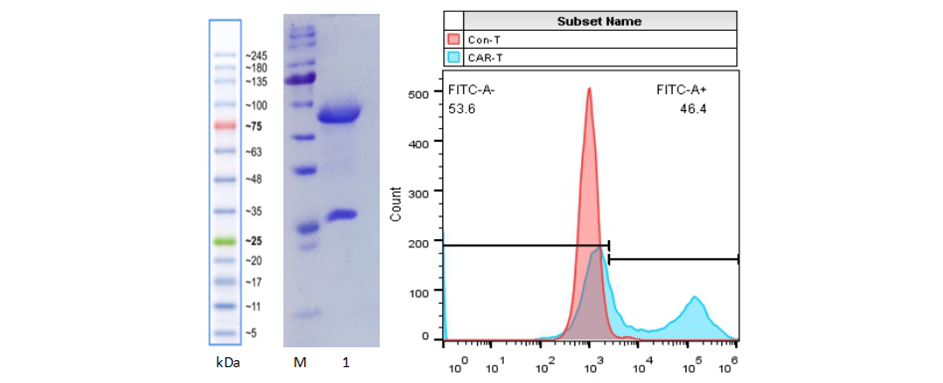FITC-EGFR Recombinant Antibody
| 【No.】IAB006A | 【Antibody name】 FITC-EGFR recombinant antibody |
| 【Antibody subtype】human IgG1 | 【Use】FACS |
| 【Packing specification】100μg/tube | 【Mode of transport】-20°C transportation |
The human EGFR protein is a transmembrane receptor, which can be used as a tyrosine kinase receptor to bind to homologous ligands, activate multiple signal levels and convert extracellular signals into appropriate cellular responses. Its cognate ligand such as epidermal growth factor ( of EGF ) and transforming growth factor sub-α (TGFα) binding cells to the extracellular domain leads to EGFR dimerization and autophosphorylation of tyrosine residues in the cytoplasmic domain of [1] . Studies have shown that the presence of many solid tumors EGFR high expression or abnormal expression, EGFR proliferation of tumor cells, angiogenesis, tumor invasion and metastasis, and inhibition of apoptosis-related [2,3] . Therefore , monoclonal antibodies targeting EGFR are often used in tumor targeted therapy. In addition, because EGFR is not expressed on the surface of T cells, when CAR-T cells are framed , the extracellular segment of EGFR can be co-expressed through the original T2A , which can indirectly reflect the expression of CAR .
This product FITC targeted conjugated EGFR monoclonal antibody of the extracellular domain (Cemab sequence ) , it can be used to EGFR overexpressing cell lines detected by flow cytometry and the CAR positive detection rate.
Product Name: EGFR Recombinant Antibody
Reactivity: human
Subclass: human IgG1
Purification method: affinity chromatography
Storage system: PBS, pH 7.4, 20% glycerol
Storage conditions: -20°C refrigerator, avoid repeated freezing and thawing

Illustration: Lane M on the left is the protein MW marker, Lane 1 is the 4ug EGFR antibody;
The picture on the right shows the FACS detection of the binding of EGFR antibody to over-expressed EGFR CART.
Reference materials:
1. EGFR signaling pathway in breast cancers: from traditional signal transduction to direct nuclear translocalization
2. Evaluation of the epidermal growth factor receptor gene mutation and
copy number in non-small cell lung cancer with gefitinib therapy
3.
Potential relationship between normalization of endometrial epidermal
growth factor profile and restoration of fertility in repeat breeder
cows
- Prev: CD276 monoclonal antibody
- Next: CD44 single chain antibody

